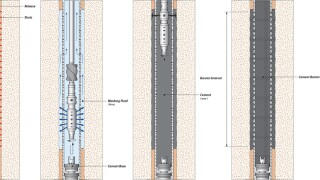Drilling
Oil and gas companies drilled 75 “high-impact” wells in 2024, representing 5.2 billion BOE.
This paper presents a comprehensive literature review of perforate, wash, and cement techniques that compares new methods with traditional ones and uses field cases and computational fluid dynamics to find the most cost- and time-effective practices without sacrificing safety.
The authors of this paper describe a method of stimulating a multizone hydrocarbon-producing well wherein a tool is deployed downhole by wireline to generate acid vapor at a target depth, allowing each interval to be treated uniquely.
-
What is observed when an unconventional well is fractured is often at odds with what was expected by those who planned the job.
-
The operator of an offshore jackup rig in the North Sea required safe and efficient deployment of the completion string without killing the well during tripping.
-
Many of us work in strong functional environments, where all too easily we can deploy solutions that have the potential for repercussions on other aspects of well design, construction, completion, and performance.
-
The Shearwater field is a deep, high-pressure/high-temperature (HP/HT) reservoir located in the UK Central Graben of the North Sea.
-
A pilot project carried out by Hess demonstrates how quickly automated drilling technology is able to take a rig from the bottom of the pack in terms of performance and push it to the top.
-
Well-control fluids were used during a routine overbalanced workover operation in an offshore well completed in high-permeability sandstone.
-
Does formation-damage coreflooding give a good representation of damage that occurs downhole? For those of us who are actively involved in coreflooding, this is a common question to be asked.
-
The inventor of a new water-based drilling fluid believes the chemical process involved with his technology opens up natural fractures as drilling takes place to increase production in shale formations.
-
This paper discusses the first multilateral well with a Level-4 junction combined with an inflow-control device (ICD) planned, designed, and drilled in the Upper Burgan reservoir of Raudhatain field, north Kuwait.
-
As with other MPD systems, SMD technology offers early detection of influxes (kicks) and minimizes downhole losses to weak subsurface formations.













